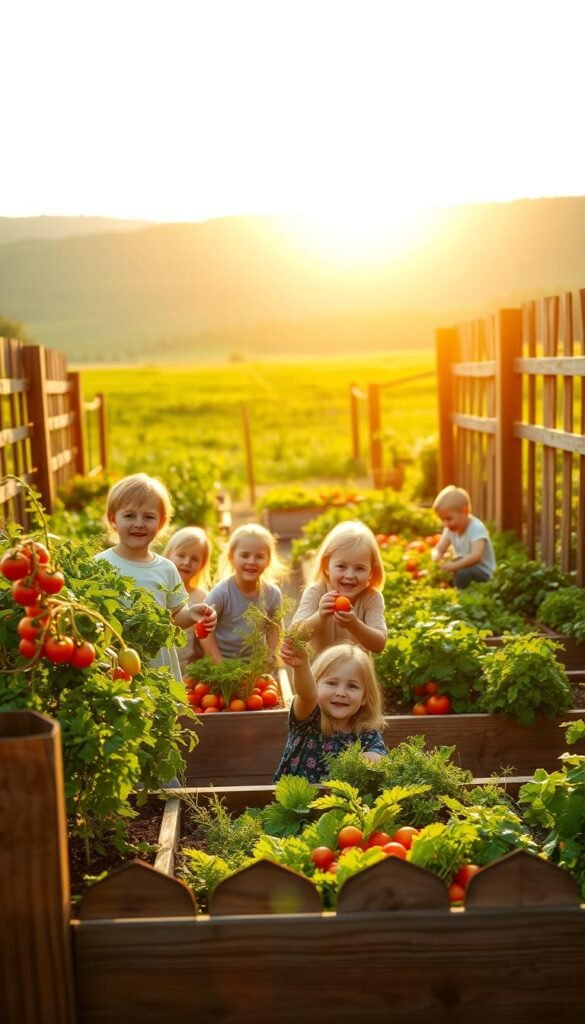Ever wonder how to get your little ones excited about nutrition? It starts by showing them where their meals begin—long before they reach the plate. When families dive into gardening or explore local farms together, they spark curiosity about food origins while creating memories that last.
Planting seeds, tending crops, and picking fresh produce aren’t just activities—they’re life lessons. Studies show hands-on experiences, like growing a themed vegetable garden, make children more likely to try new foods. Imagine your crew harvesting tomatoes for salsa or plucking herbs for homemade pizza—it’s fun, educational, and delicious!
This guide walks you through simple ways to involve your family in growing and cooking fresh ingredients. From planning a garden to exploring farmers’ markets, you’ll discover how these adventures teach responsibility, science, and the joy of eating what you’ve nurtured. Ready to dig in?
Discovering the Joy of Gardening with Your Kids

What if your next weekend adventure could turn picky eaters into veggie enthusiasts? Exploring local farms and markets transforms grocery trips into treasure hunts. These outings let your crew touch soil, sniff herbs, and taste sun-warmed strawberries straight from the vine.
Exploring Local Farms, Farmers Markets, and CSA Options
Many U.S. farms offer pick-your-own days where children fill baskets with blueberries or pumpkins. CSA programs deliver seasonal boxes of fruits and vegetables, turning meal prep into a surprise unboxing. At farmers’ markets, let kids pick one unfamiliar item—like dragon carrots—to spark kitchen experiments.
Hands-On Activities to Engage Your Children
Farms often host activity stations where families churn butter or press apple cider. Back home, try simple projects like growing basil in jars or painting plant markers. Pro tip: Pair new food tastes with familiar favorites—add rainbow chard to smoothies or roast purple potatoes as fries.
These ways of connecting with plants teach where meals begin while sneaking in science lessons. Bonus: Dirty hands and giggles are guaranteed!
Start Your Family Garden: A Practical How-To Guide

Transform your backyard into a living classroom where curiosity blooms alongside fresh produce. Whether you’re working with a sprawling yard or a sunny windowsill, growing your own plants strengthens family bonds while teaching practical skills. Let’s break down the essentials for creating a thriving green space everyone will enjoy.
Planning Your Garden Space and Choosing Containers
First, assess your available light. Most veggies need 6+ hours of daily sunlight. No yard? No problem! Use pots or repurposed buckets for compact gardens. Herbs like basil thrive in small containers, while cherry tomatoes need deeper roots—opt for 5-gallon buckets.
| Space Type | Best Plants | Container Size |
|---|---|---|
| Balcony | Lettuce, Radishes | 12″ wide pots |
| Patio | Peppers, Dwarf Carrots | 18″ deep planters |
| Yard Plot | Zucchini, Green Beans | 4×4 ft raised beds |
Step-by-Step Vegetable and Herb Growing Tips
Start with nutrient-rich soil—mix compost for a boost. Let kids poke seeds into damp earth, spacing them as directed on packets. Water gently but consistently; use a spray bottle for seedlings. Track growth with a chart to build anticipation for harvest day!
Choose fast-growing picks to maintain interest:
- Snap peas: Ready in 60 days, perfect for crunchy snacks
- Rainbow chard: Colorful leaves for stir-fries
- Pizza thyme: Fragrant addition to homemade recipes
Rotate watering duties and celebrate each sprout. Soon, you’ll have ingredients for fresh salads or cooking projects—a tasty reward for teamwork!
Healthy Eating Starts Here: Kids Harvest Their Own Vegetables

Picture your little ones grinning as they tug bright orange roots from the earth—their first homegrown carrots! The journey from seed to snack teaches patience and care while creating edible rewards. Let’s explore how nurturing plants builds lasting connections to food.
Learning the Harvest Process from Seed to Plate
Every plant tells a story. Start by comparing growth stages in a simple table:
| Stage | Kid-Friendly Task | Sample Plants |
|---|---|---|
| Sprouting | Check daily for green shoots | Lettuce, Radishes |
| Growing | Measure height weekly | Green Beans, Peas |
| Ripening | Spot color changes | Tomatoes, Peppers |
Involve your child in watering routines and observe how water transforms dry soil into lush greenery. Celebrate milestones like first blooms on zucchini plants or pea pods ready to pop open.
Encouraging Sensory Experiences and Tasting New Foods
Crunchy snap peas straight from the vine or warm cherry tomatoes burst with flavors that store-bought versions can’t match. Try these sensory activities:
- Blindfold taste tests with herbs
- Texture comparisons between raw vs cooked beans
- Rainbow veggie sorting games
When children get dirt under their nails nurturing plants, they’re more likely to embrace new eating habits. Those vibrant vegetables they helped grow? They become badges of honor—and delicious proof that health can be fun!
Creative Themed Gardens to Spark Your Child’s Interest

What if your garden could become a flavor-packed playground? Themed plots turn growing spaces into edible adventures where every plant has a purpose. These ideas blend play with practicality, letting young growers see how their efforts directly shape family meals.
Designing a Fun Pizza Garden for Family Meal Prep
Imagine plucking fresh toppings straight from the soil. A pizza-themed garden needs:
| Plant | Role | Growth Time |
|---|---|---|
| Cherry tomatoes | Sweet sauce base | 60-70 days |
| Bell peppers | Crunchy topping | 70-80 days |
| Basil & oregano | Flavor boosters | 30-40 days |
Kids love arranging these fruits vegetables on homemade crusts. Pro tip: Use herb markers shaped like pizza slices!
Crafting a Zesty Salsa and Colorful Salad Garden
A salsa corner bursts with bold flavors. Plant jalapeños, cilantro, and onions alongside tomato varieties. For salad greens, mix butter lettuce, arugula, and spinach—leafy greens that grow fast for instant gratification.
Rotate crops seasonally to teach diversity. Try purple carrots or striped beets for visual variety. When children design rainbow-themed rows, they’re more invested in tasting the results.
These garden concepts turn dirt into deliciousness. From seed to supper, every bite celebrates their growing skills—and your family’s fruits vegetables journey!
Bringing It All Together: Cultivating Lifelong Healthy Habits
Growing a garden with your family does more than fill plates—it plants seeds for lifelong wellness. Through planning plots, nurturing plants, and cooking colorful fruits vegetables, you’ve built skills that stretch far beyond the soil. Studies show 76% of families who garden together report improved eating habits, according to NIH We Can! resources.
These activity-filled adventures teach patience, science, and teamwork. Programs like Bright Horizons emphasize how tending gardens strengthens family bonds while boosting health. Rotate watering duties, track growth charts, or swap recipes using your harvest—every step becomes a shared lesson.
Keep the momentum going with free resources from local farms or online guides. Simple tips—like pairing new flavors with familiar favorites—make nutrition feel like play. Whether snapping peas off vines or blending leafy greens into smoothies, your child discovers joy in fresh food.
From seed to table, these moments shape lasting connections. The dirt under their nails? Proof they’re growing skills—and health—one crunchy carrot at a time.






